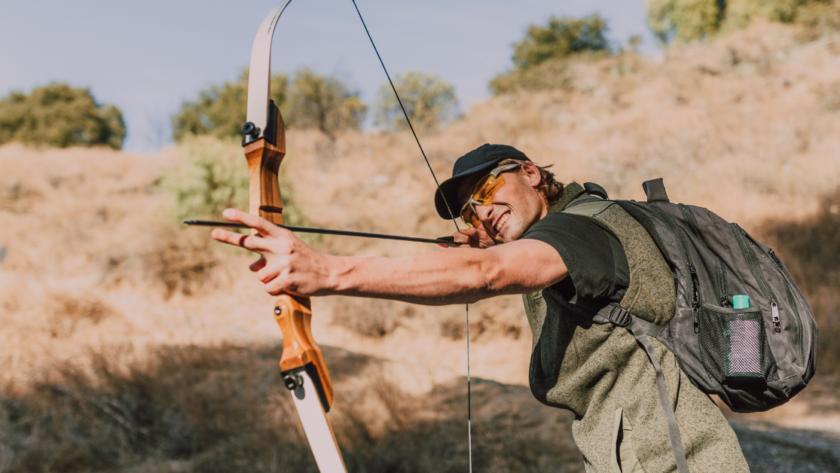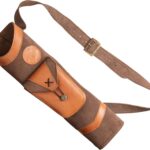As an avid archer and hunter, I’ve had the privilege of testing many bows over the years. Time and again, Hoyt hunting bows stand out for their exceptional precision, power, and field performance.
Since 1931, Hoyt Archery has been pushing the boundaries of bow technology, consistently delivering innovations that elevate the hunting experience.
In this comprehensive guide, we’ll explore the features that make Hoyt bows a top choice for hunters, how to choose the perfect Hoyt for your needs, and strategies to maximize your bow’s performance in the field.
Whether you’re a seasoned pro or just starting your bowhunting journey, understanding the intricacies of Hoyt bows can significantly enhance your hunting success.
The Hoyt Advantage: Where Technology Meets Tradition
Hoyt’s success in the hunting bow market stems from their ability to blend traditional archery principles with cutting-edge technology.
This unique approach results in bows that feel familiar to experienced archers while incorporating advanced features that push performance to new heights.
Precision Engineering
Accuracy is the cornerstone of any successful hunt, and Hoyt bows are renowned for their pinpoint precision. This reputation is built on meticulous engineering and design, exemplified by innovations like the TEC (Torsional Energy Control) riser.
The TEC riser is a game-changer in bow stability. By reducing torque and increasing overall rigidity, it confirms consistent shot placement, even in challenging hunting conditions.
When you’re perched in a tree stand or stalking through dense brush, this added stability can make the difference between a clean kill and a missed opportunity.
When selecting a Hoyt bow, pay close attention to the riser design. The TEC riser can significantly improve your accuracy, especially for longer shots where even minor inconsistencies are magnified.
Power Delivery
In bowhunting, power is crucial for ethical, clean kills. Hoyt doesn’t disappoint in this department, thanks to their advanced cam systems.
Take the ZT Hyper Cam found in the Ventum series, for example.
This innovative cam design delivers arrow speeds of up to 350 feet per second – a truly impressive feat.
High arrow speeds translate to several benefits in the field:
- Increased kinetic energy for deeper penetration
- Flatter arrow trajectories, making distance estimation less critical
- Reduced time for animals to react, leading to cleaner kills
The power of Hoyt bows allows hunters to take ethical shots at distances that might be risky with less capable equipment.
Field Performance
While precision and power are crucial, what truly sets Hoyt bows apart is their performance in real-world hunting scenarios. Hoyt understands that the controlled environment of a shooting range is vastly different from the unpredictable conditions of a hunt.
To address this, Hoyt incorporates features like advanced vibration dampening systems and noise reduction technologies. These confirm that your bow stays quiet and stealthy in the field.
When you’re trying to get close to wary game, every decibel counts. The whisper-quiet performance of Hoyt bows can make all the difference in getting that perfect shot opportunity.
Choosing the Right Hoyt Hunting Bow
With a diverse range of options available, selecting the right Hoyt bow can seem daunting. Let’s break down the process into manageable steps to help you make an informed decision.
1. Determine Your Draw Length and Weight
Your draw length and comfortable draw weight are crucial factors in selecting the right bow. Most Hoyt bows offer adjustable draw lengths and weights to accommodate different archers.
Here’s how to figure out yours:
Draw Length: Stand with your arms outstretched to your sides, parallel to the ground. Have someone measure the distance from fingertip to fingertip across your chest.
Divide this number by 2.5 to get your approximate draw length.
Draw Weight: Start with a weight you can comfortably draw and hold for at least 30 seconds. Remember, it’s better to start lighter and work your way up as you build strength and technique.
2. Consider Your Hunting Style
Different hunting styles call for different bow characteristics. Are you primarily a tree stand hunter, or do you prefer spot-and-stalk tactics?
Tree Stand Hunting: Opt for a shorter axle-to-axle length for maneuverability in tight spaces. The Hoyt Torrex, with it’s compact design, excels in these situations.
Spot-and-Stalk: Look for bows that prioritize accuracy at longer ranges. The Carbon RX series, with it’s lightweight design and exceptional stability, is ideal for this hunting style.
3. Evaluate Your Budget
Hoyt offers bows at various price points to accommodate different budgets:
- Entry-Level: The Torrex series provides excellent performance at a more affordable price point.
- Mid-Range: The Ventum series offers advanced features without breaking the bank.
- High-End: The Carbon RX series represents the pinnacle of Hoyt’s technology, with a price tag to match.
Remember, investing in a quality bow can pay dividends in hunting success and long-term durability.
4. Try Before You Buy
If possible, visit a pro shop to test different Hoyt models. Pay attention to how each bow feels in your hands and how it performs during test shots.
Factors to consider include:
- Draw cycle smoothness
- Back wall firmness
- Grip comfort
- Overall balance and feel
5. Consider Accessories
Think about what accessories you’ll need (sights, rests, stabilizers) and how they’ll combine with your chosen bow. Some Hoyt models come with pre-installed accessories, which can be a good starting point for new hunters.
Maximizing Performance in the Field
Once you’ve selected your Hoyt bow, it’s essential to improve it’s performance for hunting situations. Here are some key strategies to confirm you’re getting the most out of your equipment.
Proper Tuning
A well-tuned bow is crucial for accuracy and consistency. Here’s a basic tuning process:
- Set the nocking point: This should be about 1/8 to 1/4 inch above square.
- Adjust the arrow rest: Ensure the arrow is level and centered on the rest.
- Check cam timing: The cams should reach full draw position simultaneously.
- Paper tune: Shoot through paper at close range to check arrow flight.
- Walk-back tune: Fine-tune your sight and rest settings at various distances.
Remember, tuning is an ongoing process. Regularly check and adjust your setup, especially before important hunts.
Regular Maintenance
Keeping your Hoyt bow in top condition is crucial for consistent performance. Implement these maintenance practices:
- Inspect strings and cables for wear, replacing them every 2-3 years or sooner if needed.
- Lubricate axles and cams with a high-quality bow lubricant.
- Check all screws and bolts for tightness, but avoid over-tightening.
- Store your bow in a cool, dry place when not in use.
- Use a bow case for transportation to protect against damage.
Practice, Practice, Practice
Familiarity with your bow is key to field success. Develop a consistent practice routine:
- Shoot at various distances to understand your effective range.
- Practice from different positions (kneeling, seated, etc.) to simulate hunting scenarios.
- Use 3D targets to hone your ability to judge distances and hit vital zones.
- Practice in various weather conditions to understand how they affect your shooting.
- Incorporate physical activity into your practice sessions to simulate the elevated heart rate of a hunt.
Choose the Right Accessories
Quality accessories can enhance your Hoyt bow’s performance:
- Sights: Multi-pin sights are versatile for hunting.
Consider models with fiber optic pins for low-light visibility.
- Rests: Drop-away rests are popular for their accuracy and arrow clearance.
- Stabilizers: These reduce vibration and improve balance.
Experiment with different lengths and weights.
- Arrows: Match your arrows to your bow’s specifications for optimal performance.
- Broadheads: Practice with the same broadheads you’ll use for hunting to confirm accuracy.
Understand Your Limitations
While Hoyt bows are capable of impressive long-range accuracy, it’s crucial to know your effective range and stick to ethical shot distances when hunting. Factors to consider include:
- Your personal accuracy at various distances
- The size of the animal’s vital zone
- Environmental conditions (wind, terrain, etc.)
- Your physical condition and stress level during the hunt
Remember, just because you can make a shot at the range doesn’t mean it’s ethical in a hunting situation.
Common Pitfalls to Avoid
Even with a top-quality Hoyt bow, there are some common mistakes that can hinder your hunting success. Being aware of these pitfalls can help you avoid them and improve your overall performance.
Over-bowing
Choosing a draw weight that’s too heavy is a common error, especially among new archers eager to maximize their bow’s potential. However, an overly heavy draw weight can lead to:
- Poor shooting form
- Reduced accuracy
- Fatigue during long hunting sessions
- Potential injury
Start with a comfortable draw weight and gradually increase it as your strength and technique improve. Remember, accuracy trumps raw power in most hunting situations.
Neglecting Form
Even the best bow can’t compensate for poor shooting form. Common form issues include:
- Inconsistent anchor point
- Peeking (moving your head to watch the arrow)
- Punching the trigger (sudden release instead of a smooth squeeze)
- Improper follow-through
Focus on maintaining proper technique, especially under hunting conditions where excitement and adrenaline can affect your form.
Inadequate Broadhead Tuning
Many archers make the mistake of assuming their broadheads will fly like their field points. However, broadheads can significantly affect arrow flight.
To confirm accuracy:
- Test your broadheads well before hunting season
- Make necessary adjustments to your bow setup
- Practice with the same broadheads you’ll use for hunting
Overconfidence in Technology
While Hoyt bows offer advanced features, they’re not a substitute for skill and practice. Avoid relying solely on technology to make up for lack of preparation.
Instead:
- Use technology as a tool to enhance your skills
- Continue to practice basic archery techniques
- Understand the limitations of your equipment
Ignoring the Basics
In the excitement of using a high-tech bow, don’t forget basic hunting skills like:
- Scent control
- Understanding wind direction
- Stealth and movement discipline
- Proper shot placement
These basic skills often make the difference between a successful hunt and a missed opportunity.
Adapting to Different Hunting Scenarios
One of the strengths of Hoyt bows is their versatility. Let’s explore how to adapt your Hoyt setup for different hunting situations.
Tree Stand Hunting
When hunting from an elevated position, consider these adjustments:
- Use a shorter axle-to-axle bow like the Hoyt Torrex for better maneuverability in tight spaces.
- Opt for a lighter overall setup to reduce fatigue during long sits.
- Choose a quiver that allows for easy arrow removal without excess movement.
- Practice shooting from an elevated position to understand trajectory changes.
Spot-and-Stalk Hunting
For this active hunting style, prioritize:
- A lightweight setup for easier carrying over long distances.
The Carbon RX series excels here.
- Longer axle-to-axle bows for increased stability on longer shots.
- High-quality rangefinding equipment for accurate distance estimation.
- Quieter accessories to minimize noise during stalks.
Cold Weather Hunting
Extreme temperatures can affect bow performance. Hoyt’s carbon fiber risers maintain consistency in cold conditions.
Additional considerations include:
- Using all-weather strings that won’t stretch or contract with temperature changes.
- Choosing lubricants that won’t thicken in cold temperatures.
- Practicing with the same layers you’ll wear while hunting to account for changes in form.
Western Big Game Hunting
For longer shots in open terrain:
- Consider a longer axle-to-axle bow like the Hoyt Ventum for increased stability.
- Invest in high-quality optics for target acquisition at extended ranges.
- Use heavier arrows for better wind resistance and increased kinetic energy.
- Practice judging distances in varied terrain to improve your ranging skills.
Dense Forest Hunting
In tight quarters where quick shots are common:
- Opt for a more compact bow with a smooth draw cycle.
- Use a single-pin adjustable sight for faster target acquisition.
- Choose a shorter stabilizer to reduce the chance of snagging on brush.
- Practice snap-shooting and instinctive aiming for those fleeting shot opportunities.
Building on the Basics
Mastering a Hoyt hunting bow is an ongoing process that builds on basic archery skills. As you become more proficient, you’ll find that the advanced features of Hoyt bows allow you to push your limits and take on more challenging hunting scenarios.
To continue improving, focus on:
- Fine-tuning your form for most efficiency with your Hoyt bow’s cam system.
- Understanding the nuances of your bow’s ballistics at various ranges and conditions.
- Exploring advanced shooting techniques like instinctive aiming or gap shooting.
- Experimenting with different arrow and broadhead combinations to improve performance.
- Participating in 3D archery tournaments to hone your skills under pressure.
Practical Exercises to Enhance Your Skills
To truly master your Hoyt hunting bow, incorporate these exercises into your practice routine:
Long-Range Accuracy
Set up targets at various distances beyond your comfort zone. This exercise helps you:
- Improve distance estimation skills
- Understand how minor form inconsistencies affect accuracy at range
- Build confidence for those longer shot opportunities
Shooting from Elevation
If you hunt from tree stands, practice shooting from elevated positions. This simulates real hunting scenarios and helps you:
- Understand how elevation affects arrow trajectory
- Practice proper form in an awkward position
- Develop strategies for range estimation from height
Rapid Target Acquisition
Set up many targets and practice quickly acquiring and shooting each one. This exercise:
- Improves your ability to make quick, ethical shots in the field
- Enhances your mental focus under pressure
- Helps develop a smoother draw cycle and release
Stress Shooting
Incorporate physical activity (like sprints or push-ups) before taking shots. This simulates the elevated heart rate you might experience during a hunt and helps you:
- Maintain accuracy under physical stress
- Develop breath control techniques
- Understand your physical limitations
Low-Light Practice
Since many hunting opportunities occur at dawn or dusk, practice shooting in low-light conditions. This builds confidence and helps you:
- Understand how your sight picture changes in different light
- Develop strategies for shot timing in limited visibility
- Test the effectiveness of your bow sight in various light conditions
People Also Asked
What is the best Hoyt bow for beginners?
The Hoyt Torrex is an excellent choice for beginners. It offers adjustable draw length and weight, making it versatile for growing archers.
It’s forgiving nature and smooth draw cycle help new hunters develop proper form.
How fast do Hoyt hunting bows shoot?
Hoyt’s top-end bows, like the Ventum Pro, can achieve arrow speeds up to 350 feet per second. However, actual speed depends on factors like draw length, arrow weight, and bow setup.
Are Hoyt bows worth the price?
Hoyt bows are known for their quality, durability, and performance. While they come at a premium price, many hunters find the investment worthwhile due to the bows’ longevity and hunting success.
How often should I replace the strings on my Hoyt bow?
Generally, it’s recommended to replace strings and cables every 2-3 years or after about 2,500 shots, whichever comes first. However, inspect them regularly and replace sooner if you notice wear or fraying.
Can I hunt all big game with a Hoyt bow?
Yes, Hoyt offers bows suitable for hunting all North American big game. Choose a bow with suitable draw weight and arrow setup for the game you’re pursuing.
What’s the difference between Hoyt’s aluminum and carbon riser bows?
Carbon riser bows, like the RX series, are lighter and maintain consistency in extreme temperatures. Aluminum riser bows, like the Ventum, offer similar performance at a lower price point but are slightly heavier.
How do I properly maintain my Hoyt bow?
Regular maintenance includes inspecting strings and cables, lubricating moving parts, checking screw tightness, and storing the bow in a cool, dry place. Avoid dry-firing and use a bow press for any adjustments requiring relaxation of the limbs.
What accessories do I need for my Hoyt hunting bow?
Essential accessories include a sight, arrow rest, stabilizer, and quiver. Additional items like a peep sight, D-loop, and silencers can enhance performance and stealth.
How long does it take to become proficient with a Hoyt hunting bow?
With regular practice, most archers can become proficient within 3-6 months. However, mastery is an ongoing process that can take years of dedicated practice and hunting experience.
Can I use my Hoyt hunting bow for target archery?
Absolutely. Many Hoyt hunting bows perform excellently in target archery competitions.
Some models, like the Invicta, are designed to excel in both hunting and target scenarios.
Key Takeaways
- Hoyt bows excel in precision, power, and field performance due to innovative designs like the TEC riser and advanced cam systems.
- Choose a Hoyt bow that matches your draw length, hunting style, and budget. Consider factors like axle-to-axle length and adjustability.
- Proper tuning and regular maintenance are crucial for optimal performance. Develop a routine for checking and adjusting your bow.
- Practice regularly, focusing on form and simulating various hunting scenarios to build skill and confidence.
- Adapt your Hoyt setup for different hunting situations, considering factors like terrain, weather, and game type.


